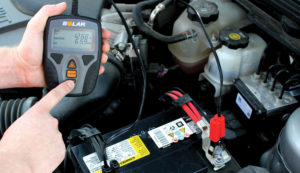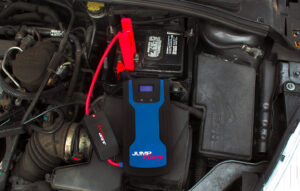A battery load tester is a reasonably safe device when used properly. Load testers are commonly found in auto repair shops, municipal fleet facilities, and even residential garages where car guys and girls restore their beloved classic cars. But, as with any piece of automotive equipment, safety precautions should be followed to ensure safe usage.
Use a battery load tester the right way and you have nothing to worry about. But do things the wrong way and you could put yourself in danger or cause damage to your vehicle. Always remember that batteries contain chemicals that could prove quite harmful if you come into contact with them or if they leak into the vehicle itself.
Just to keep our readers in the right mindset where battery load testers are concerned, here are some of the most common safety precautions associated with their use:
1. Wear Proper Protective Clothing
It is always a wise idea to wear eye protection when working around vehicle batteries. Protective clothing, such as gloves and bibs, are a good idea as well. Lead acid batteries produce hydrogen gas during normal operation. If something goes wrong during a load test conducted while there is an excess of hydrogen gas in the battery compartment, the hydrogen can actually explode.
Hand-in-hand with proper protective clothing is the chosen location for testing. Experts recommend always using a battery load tester in a well-ventilated space. It is best for this space should have access to fresh air as well.
2. Avoids Sparks at All Costs
Due to the flammable nature of the gases potentially emitted by vehicle batteries, always take steps to avoid sparks during load testing. Following all load tester manufacturer operating instructions and those of the battery/vehicle manufacturer of the equipment being tested is critical when it comes to avoid sparks and operating safely (more below).
It goes without saying that flames should be avoided as well. Do not even think about smoking or lighting a match while standing near a vehicle battery or near a battery load tester in action.
3. Follow Manufacturer Instructions
Just about every battery load tester comes with instructions from the manufacturer. Avoid the temptation to throw the instructions away without ever reading them. In fact, read, understand, and save instruction manuals. Make sure to follow the instructions to the letter.
For example, the instructions are likely to suggest:
- Paying close attention to battery polarity.
- Folowing the correct connection and disconnection sequences.
- Never attaching or removing battery clamps while the load tester is on.
- Neutralizing acid spills on the battery before connecting the tester.
- Removing jewelry (like rings and watches) prior to testing.
Manufacturers know how their devices work. The instructions they include are intended to do two things: keep users safe and ensure effective operation of the equipment. It is always in your best interests to heed those instructions.
4. Do Not Load Test Damaged Batteries
The point of using a battery load tester is to measure a battery‘s performance under a load, simulating the load it would experience during starting. Starting puts tremendous stress on the battery. So does load testing. This leads to one obvious conclusion: you should never load test a known damaged battery. If a battery is cracked, send it off to the recycling center. If it is frozen, do not put it on a load tester. A battery that offers even the slightest hint of potential damage is off limits for testing. Damaged batteries are too risky because they can explode.
If you are an auto repair professional, you may have your own personal safety precautions not explained in this post. All we can say is, good for you. Battery load testers are normally very safe devices. But any device can be used improperly. And when it is used improperly, a load tester, like many other types of equipment, can present dangers to the operator and the equipment being serviced. So, it is best to follow all the standard safety precautions and have a safety-first mindset when working on vehicles and around vehicle batteries.




